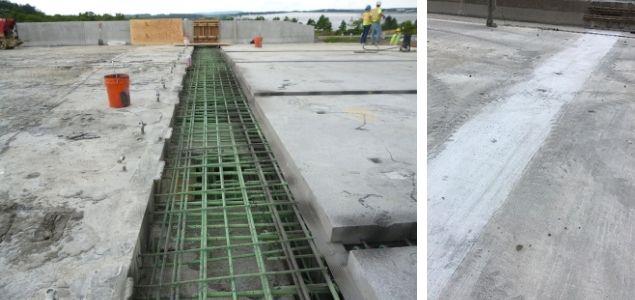
Faced with the responsibility for one of the nation’s largest bridge networks, PennDOT is working toward use of an effective Accelerated Bridge Construction material to help expedite bridge repairs and aid in bridge preservation.
Nearly every one of PennDOT’s 11 engineering districts has already completed at least one bridge construction project using Ultra-High Performance Concrete (UHPC) Connections for Prefabricated Bridge Elements (PBE), a Federal Highway Administration (FHWA) Every Day Counts Round 3 (EDC-3) innovation that PennDOT championed.
Now, as part of FWHA EDC Round 6 (EDC-6), PennDOT is championing the use of UHPC for Bridge Preservation and Repair (P&R). Tyler Culhane, senior civil engineer in PennDOT’s bridge division; Patricia Baer, unit manager at PennDOT’s Materials Testing Laboratory; and Jason Zang, P.E., assistant district executive for construction in PennDOT’s District 11 in the Pittsburgh region, are serving as the PennDOT champions for this innovation.
UHPC is a steel fiber-reinforced cement-based composite materials that has exceptionally high mechanical strength and durability properties that far exceed those of conventional concrete materials.
“This is not a typical concrete material,” Baer noted. “It works well for connections … It gets very high strength quickly … It’s a whole different animal than conventional concrete.”
With DOTs and other highway agencies across the nation working to keep bridges in a state of good repair, use of UHPC for Bridge P&R is a new method that offers enhanced performance and improved life-cycle costs over traditional methods.
According to Culhane, only District 1 has used UHPC for Bridge P&R purposes, a bridge link slab retrofit on the State Route 1009 bridge over Lake Wilhelm in Mercer County. The bridge involves three spans, two prestressed spread box beams and one adjacent box beam, connected with UHPC link slabs.
Use of Bridge Link Slabs to help address bridge deck joint failure, a common maintenance issue in Pennsylvania, is an innovation currently being pursued by the State Transportation Innovation Council (STIC). Mark Nicholson, PennDOT District 1 bridge engineer, is spearheading the development of this innovation. This is just one of many ways UHPC can help extend the service life of bridges.
According to FHWA, UHPC P&R applications include bridge deck overlays, girder end repairs, expansion joint repairs, PBE construction joint repairs and column or pile jacketing. Some applications, such as bridge deck overlays and replacing expansion joints with UHPC link slabs can extend the service life of bridges well beyond that of traditional repair strategies and are more cost-efficient than bridge replacement.
Future plans for use of UHPC for Bridge P&R included a pilot project using UHPC for a bridge deck overlay and additional pilot projects in the districts using UHPC for various bridge rehabilitations and repairs. The innovation implementation team also plans to evaluate the impact of UHPC on bridge life-cycle costs.
Zang said UHPC is ultimately going to be a big factor in speeding up bridge repair projects, resulting in life-cycle cost savings. This is critically important given that Pennsylvania is home to roughly 25,000 state-maintained bridges and roughly 6,000 locally managed bridges.
PennDOT has instituted a special provision for UHPC use across the state, and the innovation team is working to have the UHPC added to Publication 408, PennDOT’s Construction Specifications as well as Bulletin 15, PennDOT’s Qualified Products List for Construction.
Once that is accomplished, more suppliers will come forward and help generate more competitive pricing, Zang said.
ABOUT THIS BLOG
Did you know PennDOT is directly responsible for nearly 40,000 miles of highway and roughly 25,000 bridges? We oversee programs and policies affecting highways, urban and rural public transportation, airports, railroads, ports and waterways, in addition to administering the state's more than 11 million vehicle registrations and 8.8 million driver's licenses.
So, how do we do what we do? And how can we help you travel in Pennsylvania — whether it be for business or leisure — in safe and enjoyable manner? Read PennDOT Way to learn more about the department, what we do, and how and why we do it.
TAGS
50-Year Anniversary, 511PA, Aggressive Driving, Airports, Autonomous Vehicles, Bicycles, Bridges, Child Safety, Community Relations, Construction, COVID-19, Distracted Driving, District 1, District 10, District 11, District 12, District 2, District 3, District 4, District 5, District 6, District 8, District 9, DOTcom, Driver and Vehicle Services, Emergency Responders, Employment, Equity, FAQ Friday, Human Trafficking, Impaired Driving, Innovations, Live Free Ride Alive, Maintenance Monday, Motorcycles, Older Drivers, PA Motorcycle Safety Program, Pedestrians, PennDOT Connects, Ports, Public Transit, Railroads, REAL ID, Road MaP, Roadside Beautification, Rural Roads, Safety, School Buses, Seat Belts, State Transportation Innovation Council (STIC), Sustainability, Teen Drivers, Throwback Thursday, Transportation Funding, Travel in PA, Welcome Centers, Winter, Work Smart, Work Zone, Yellow Dot
LATEST POSTS
PennDOT Continues Sharing, Updating Resources for Local Governments to Pursue Bipartisan Infrastructure Law Funding Opportunities
Norwin High School Wins 2024 ‘Innovations Challenge’
Demo Complete: I-95 CAP Project in Center City Philadelphia
PennDOT Archeologist Connects Past, Present, and Future
Lehigh Valley DUI, Highway Safety Task Force Hosts Law Enforcement Seminar
ARCHIVES
2024
2023
2022
2021
2020
2019
2018
2017

